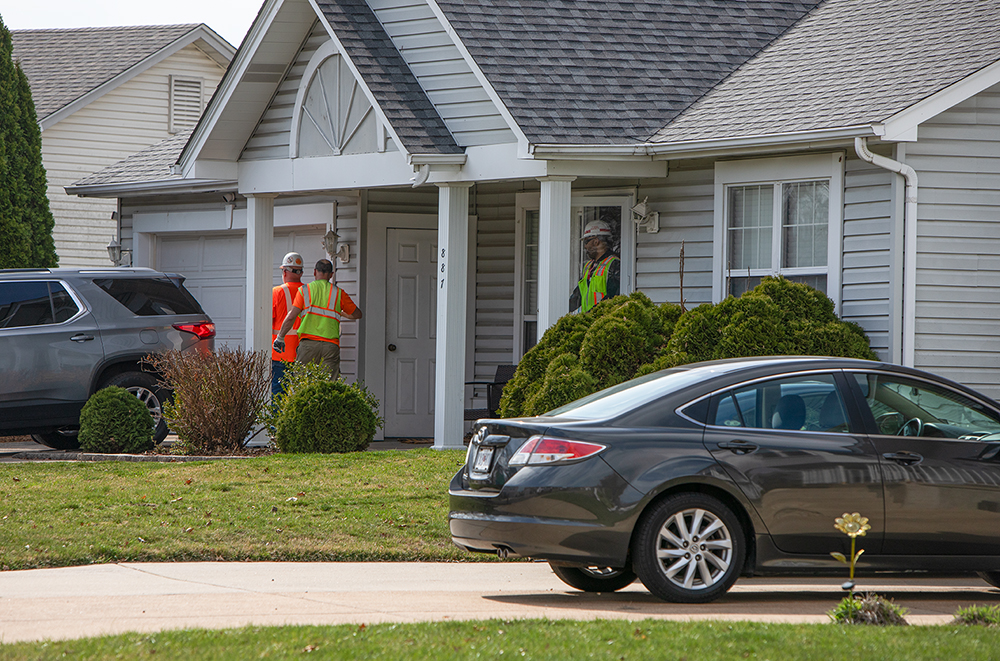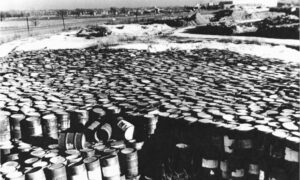17:00
News Story
Florissant homes built on Coldwater Creek may sit on radioactive contamination
The U.S. Army Corps of Engineers is drilling through basement floors in the Cades Cove subdivision of Florissant to determine whether there is radioactive contamination under residents’ homes
Federal officials are investigating whether residents of a small subdivision in the St. Louis suburbs are living on top of contamination dating back to World War II after finding radioactive material in their backyards.
The Cades Cove subdivision, a small enclave in Florissant, was built on top of where Coldwater Creek once meandered. The creek, which runs through several St. Louis suburbs and into the Missouri River, was contaminated decades ago by waste left over from the development of the world’s first atomic bomb.
Now, 78 years after the U.S. dropped two atomic bombs on Japan, waste from their development lingers in Cades Cove residents’ backyards. And federal officials are drilling through their basement floors to determine whether it’s under their homes.
“There are homes built on top of the Manhattan Project in St. Louis,” said Dawn Chapman, a co-founder of Just Moms STL, an advocacy group for affected communities, “and there are residents who have been living in those homes on top of this for decades.”
Chapman was speaking on a press conference call about legislation that would compensate St. Louis-area residents who have developed illnesses because of exposure to radioactive waste.
“This is not a 50-year-old problem,” Chapman said. “This is a today problem.”
Records reveal 75 years of government downplaying, ignoring risks of St. Louis radioactive waste
Following the conference call and media inquiries on Monday, the U.S. Army Corps of Engineers, which is responsible for cleaning up Coldwater Creek and surrounding properties, announced the sampling efforts in a news release. The agency said it was planning a public meeting.
Phil Moser, a program manager for the U.S. Army Corps of Engineers, said in an interview with The Independent that the agency, which is responsible for cleaning up Coldwater Creek, discovered radioactive contamination in several backyards in Cades Cove, leading officials to sample under residents’ foundations.
Moser said it’s the first time since the agency began sampling efforts — meant to inform its cleanup plan — that it has needed to go inside residents’ homes to collect samples. He called the neighborhood an “outlier” for its contamination in residents’ yards.
Contamination in Cades Cove, Moser said, has been found deep underground because the creek meander was filled in with dirt when the neighborhood was built more than 30 years ago. He said several yards will need to be remediated.
It’s less clear what will happen if contamination is discovered under residents’ homes. Moser said the Army Corps is going to ensure it gets all the contamination. Asked if homes may need to be demolished or whether residents might have to move, Moser said he couldn’t speak about hypotheticals.
“We’re not taking anything off the table as far as what we would eventually have to do,” he said.
He said “no matter what” the agency will remove all the contamination.
In an email to activists about the sampling and in an interview with The Independent, Moser said the agency had been in contact with Cades Cove residents and the local homeowners’ association.
“As expected, this is a difficult time for (residents) to navigate and we are striving (to) not make it worse with too much outside attention,” Moser said in an email to activists. The Corps’ St. Louis spokesman, Jeremy Idleman, said the same in an emailed statement.
Parts of St. Louis and surrounding counties have been contaminated for decades by waste generated during the Manhattan Project, the name given to the effort to build the world’s first atomic bomb. Uranium refined in downtown St. Louis was used in the first sustained nuclear reaction in Chicago, a key breakthrough in the bomb’s creation.
After the war, waste generated from uranium processing was trucked to St. Louis County and dumped, uncovered, at the airport, right next to Coldwater Creek. Wind and rain spread the waste, polluting the creek for miles. Over the ensuing decades, tons of waste were moved around St. Louis and St. Charles counties, polluting numerous sites.
Radioactive contamination remains at sites around the St. Louis metro today, and the cleanup of Coldwater Creek and surrounding properties is expected to take until 2038.
Even at the time the homes in Cades Cove were built, the federal government had known for years that radioactive waste stored nearby had polluted Coldwater Creek. An investigation published last summer by The Missouri Independent, MuckRock and The Associated Press revealed that federal officials and the company that refined uranium for the Manhattan Project knew the waste posed a risk to St. Louis residents for years before acknowledging it to the public.
“I’m angry,” said Karen Nickel, Chapman’s fellow co-founder, who visited the neighborhood Monday. “I’m angry. I’m frustrated, disappointed, and I feel very, very bad for the people that are living in those homes, living in that subdivision.”
Nickel said Just Moms hopes to share resources and information with Cades Cove residents and ensure those outside the neighborhood know what is being found. She criticized the Army Corps for not making the findings public more quickly.
“Stop using this excuse,” Nickel said. “…the rest of this community has the right to know.”
The revelation of the Cades Cove contamination comes at a time when St. Louis’ radioactive contamination is in the spotlight.
The U.S. Senate is expected to vote this week on legislation that would expand the Radiation Exposure Compensation Act to residents of Missouri sickened by radioactive waste and several western states where atomic bomb testing exposed huge swaths of the nation to airborne radioactivity.
And Chapman is attending President Joe Biden’s State of the Union Address on Thursday as U.S. Sen. Josh Hawley’s guest.
The Riverfront Times’ Zach Linhares contributed to this report.
Our stories may be republished online or in print under Creative Commons license CC BY-NC-ND 4.0. We ask that you edit only for style or to shorten, provide proper attribution and link to our website. AP and Getty images may not be republished. Please see our republishing guidelines for use of any other photos and graphics.





